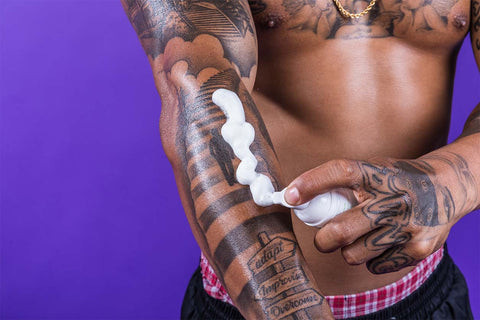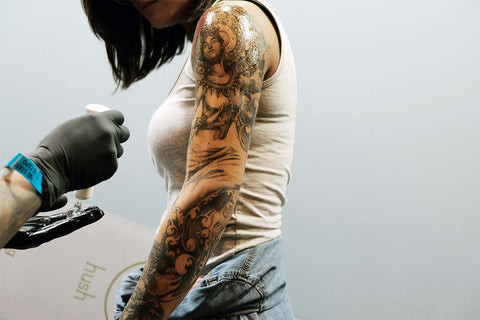Getting a tattoo is often compared to other types of pain, and a common question is: Does A Tattoo Feel Like Getting A Shot? At tattooat.com, we delve into the specifics of tattoo sensations and the art of body modification, offering insights that help you understand what to expect and make informed decisions. While the sensation can vary, it generally differs from a shot in key ways.
Choosing to get inked is a significant step, and understanding the experience is crucial. With tattooat.com, explore diverse designs, find talented artists, and learn all about tattoo aftercare. Let’s unpack the realities of tattoo pain, differentiating it from other familiar discomforts, and giving you the lowdown on managing it effectively.
1. What Does Getting a Tattoo Feel Like Compared to a Shot?
The sensation of getting a tattoo is often described differently than receiving an injection. While a shot involves a quick, sharp prick, tattooing involves repeated punctures over a larger area.
- The Shot Experience: Shots usually involve a single, rapid injection. The pain is sharp but brief, often localized to a small area.
- The Tattoo Experience: Tattoos, on the other hand, involve a sustained, scratching or burning sensation. The pain is more prolonged and covers a larger surface, leading to a different kind of discomfort.
The type of pain experienced during a tattoo session can vary based on factors such as tattoo placement, individual pain tolerance, and the specific technique used by the artist.
2. What Factors Influence the Pain Level of a Tattoo?
Several elements can play a key role in how painful a tattoo might feel. Here are some of the critical factors to consider:
2.1. Tattoo Placement
The location of the tattoo significantly impacts pain levels. Areas with more nerve endings or thinner skin tend to be more sensitive.
- High-Pain Areas: These include the ribs, head, neck, inner thighs, and areas near joints like elbows and knees.
- Lower-Pain Areas: Areas like the outer thighs, upper arms, and fleshy parts of the calves are generally less painful.
2.2. Tattoo Size and Design Complexity
Larger and more intricate tattoos typically require longer sessions, leading to increased discomfort over time.
- Simple Designs: Small, straightforward designs may be relatively quick and less painful.
- Complex Designs: Detailed, large-scale tattoos can be more painful due to the extended time and repeated passes over the same areas of skin.
2.3. Individual Pain Tolerance
Everyone experiences pain differently. Factors such as genetics, mental state, and overall health can influence your pain tolerance.
- High Pain Tolerance: Some individuals naturally have a higher threshold for pain and may find tattoos more manageable.
- Low Pain Tolerance: Others may be more sensitive and experience tattoos as more painful.
2.4. Tattoo Artist Technique
The skill and technique of the tattoo artist can also affect the pain level.
- Experienced Artists: Skilled artists tend to work efficiently, minimizing trauma to the skin and reducing pain.
- Inexperienced Artists: Less experienced artists may apply more pressure or take longer, potentially increasing discomfort.
2.5. Mental and Physical State
Your mental and physical condition on the day of your appointment can also play a role.
- Stress and Anxiety: Being stressed or anxious can heighten your sensitivity to pain.
- Hydration and Rest: Proper hydration and adequate rest can help you better manage pain.
Address: 1825 SW Broadway, Portland, OR 97201, United States. Phone: +1 (503) 725-3000. Website: tattooat.com.
3. How Do People Describe the Pain of Getting a Tattoo?
Personal experiences can vary widely, but some common descriptions include:
- Burning: A sensation similar to a sunburn or a hot object pressing against the skin.
- Scratching: Like a cat scratch, but more intense and prolonged.
- Vibration: A buzzing or vibrating feeling, especially with rotary tattoo machines.
- Dull Ache: A throbbing pain that can linger after the tattoo session.
- Sharp Stinging: Similar to a bee sting, especially in sensitive areas.
According to research from Portland State University’s Art Department, in July 2025, tattoo pain is subjective, with descriptions varying widely, but understanding these sensations can prepare individuals for the experience.
4. What Are the Differences Between Machine Tattoos and Stick and Poke Tattoos?
The method used to apply a tattoo can significantly affect the sensation experienced.
4.1. Machine Tattoos
Machine tattoos use a powered device with needles that rapidly move up and down to insert ink into the skin.
- Consistency: Machine tattoos tend to provide more consistent and precise results.
- Speed: They are generally faster than stick and poke tattoos, reducing the overall time of discomfort.
- Sensation: Many describe the sensation as a vibrating or buzzing feeling.
4.2. Stick and Poke Tattoos
Stick and poke tattoos, also known as hand-poked tattoos, involve manually inserting ink into the skin using a single needle.
- Precision: Requires careful and precise hand movements.
- Time: Significantly slower than machine tattoos, which can lead to longer periods of discomfort.
- Sensation: Often described as a series of pinches or pricks.
4.3. Comparing the Pain
The pain levels can vary depending on individual tolerance and the specific area being tattooed, but generally:
- Machine Tattoos: The consistent, rapid action can sometimes be perceived as less painful over time for some people.
- Stick and Poke Tattoos: The slower, manual process may feel more intense due to the deliberate and individual punctures.
5. How Can You Prepare for Your First Tattoo to Minimize Pain?
Preparing adequately can make a significant difference in your tattoo experience.
5.1. Choose the Right Time
Select a date when you’re likely to be relaxed and free from significant stress.
- Avoid Busy Periods: Don’t schedule your tattoo during hectic times at work or personal life.
- Prioritize Rest: Ensure you get a good night’s sleep before your appointment.
5.2. Stay Hydrated and Eat Well
Proper hydration and nutrition can help stabilize your body and improve your pain tolerance.
- Drink Plenty of Water: Start hydrating a few days before your appointment.
- Eat a Balanced Meal: Have a nutritious meal a few hours before getting tattooed to maintain stable blood sugar levels.
5.3. Avoid Alcohol and Caffeine
These substances can increase sensitivity and anxiety.
- Alcohol: Avoid alcohol for at least 24 hours before your appointment, as it can thin your blood and increase bleeding.
- Caffeine: Limit caffeine intake on the day of your tattoo to reduce nervousness.
5.4. Wear Comfortable Clothing
Choose clothing that allows easy access to the area being tattooed and keeps you comfortable.
- Loose Clothing: Opt for loose-fitting clothes that won’t rub against the new tattoo.
- Appropriate Attire: Dress in layers to adjust to the temperature of the tattoo studio.
5.5. Mentally Prepare
Knowing what to expect and practicing relaxation techniques can help manage anxiety.
- Research: Understand the tattoo process and what to expect during and after the session.
- Relaxation Techniques: Practice deep breathing, meditation, or visualization to calm your nerves.
 Woman Getting Arm Tattooed
Woman Getting Arm Tattooed
6. What Numbing Options Are Available for Tattoos?
If you’re concerned about pain, consider using numbing products.
6.1. Topical Anesthetics
These creams and gels are applied to the skin to reduce sensation.
- Lidocaine Creams: Over-the-counter and prescription options are available.
- Application: Apply liberally to the area about an hour before your appointment, following the product instructions.
6.2. Numbing Sprays
Sprays containing lidocaine can be used during the tattoo process to alleviate pain.
- Usage: The tattoo artist can apply the spray as needed during the session.
- Effectiveness: Provides temporary relief and can make the process more comfortable.
6.3. Professional Anesthetics
Some tattoo artists may offer stronger numbing agents.
- Consultation: Discuss these options with your artist beforehand to ensure they are safe and appropriate for your skin.
- Availability: Not all artists offer these, so it’s important to inquire in advance.
7. What Aftercare Steps Can Help Manage Discomfort After Getting a Tattoo?
Proper aftercare is crucial for healing and minimizing discomfort.
7.1. Keep the Tattoo Clean
Gently wash the tattoo with mild, fragrance-free soap.
- Frequency: Wash the area 2-3 times a day to remove bacteria and prevent infection.
- Technique: Use your fingertips to gently cleanse the tattoo, avoiding harsh scrubbing.
7.2. Apply a Moisturizing Ointment
Use a tattoo-specific aftercare ointment to keep the skin hydrated.
- Purpose: Moisturizing helps prevent scabbing and promotes faster healing.
- Application: Apply a thin layer of ointment after washing the tattoo.
7.3. Avoid Sun Exposure
Protect your tattoo from direct sunlight.
- Sunscreen: Once the tattoo is fully healed, use a high-SPF sunscreen to prevent fading.
- Clothing: Cover the tattoo with loose clothing if you’re going to be outdoors.
7.4. Stay Hydrated
Drinking plenty of water supports overall skin health and healing.
- Water Intake: Aim for at least eight glasses of water a day.
- Benefits: Hydrated skin heals faster and looks better.
7.5. Avoid Irritants
Steer clear of activities and substances that can irritate the tattoo.
- Swimming: Avoid swimming in pools, oceans, or hot tubs until the tattoo is fully healed.
- Tight Clothing: Wear loose clothing to prevent rubbing and irritation.
8. What Are Common Misconceptions About Tattoo Pain?
Many myths surround the experience of getting a tattoo.
8.1. Myth: Tattoos Always Hurt Terribly
Reality: Pain levels vary. While tattoos can be uncomfortable, many people find the sensation manageable, especially with proper preparation and numbing agents.
8.2. Myth: All Tattoo Locations Hurt the Same
Reality: Some areas are more sensitive than others. Bony areas and those with many nerve endings tend to be more painful.
8.3. Myth: Men Tolerate Tattoo Pain Better Than Women
Reality: Pain tolerance is individual and not strictly related to gender. Some people have higher pain thresholds regardless of their sex.
8.4. Myth: Alcohol Helps Numb the Pain
Reality: Alcohol thins the blood and can increase bleeding during the tattoo process, making it more painful and affecting the quality of the tattoo.
8.5. Myth: Once You Have One Tattoo, All Others Will Hurt Less
Reality: While familiarity with the process can reduce anxiety, the pain level depends on the location, size, and complexity of each individual tattoo.
9. How Do Different Tattoo Styles Affect Pain Levels?
The style of tattoo can influence how much pain you experience.
9.1. Fine-Line Tattoos
These delicate tattoos involve thin, precise lines.
- Pain Level: Generally less painful than tattoos with heavy shading or bold lines.
- Technique: Requires a skilled artist to ensure clean lines without excessive pressure.
9.2. Traditional Tattoos
Traditional tattoos often feature bold outlines and solid colors.
- Pain Level: Can be more painful due to the extensive shading and outlining.
- Technique: Requires multiple passes over the same area to achieve the desired saturation.
9.3. Realism Tattoos
Realism tattoos aim to replicate photographs or lifelike images.
- Pain Level: Varies depending on the amount of detail and shading involved.
- Technique: Often requires long sessions and intricate work, which can increase discomfort.
9.4. Blackwork Tattoos
Blackwork tattoos use large areas of solid black ink.
- Pain Level: Can be quite painful due to the extensive coverage and multiple passes.
- Technique: Requires precision and patience to achieve a smooth, even finish.
 Tattoo artist working on a client's arm
Tattoo artist working on a client's arm
10. What Are Some Personal Accounts of Tattoo Pain?
Hearing from others can provide a realistic expectation of what to expect. Here are some experiences shared by individuals:
- Amber: “Every tattoo I’ve gotten has felt kind of like a continuous bee sting. Some spots hurt more than others, and shading nearly makes me pull my hair out.”
- Jordan: “Getting the tattoo hurt less than how it felt a few hours after when it started to prickle and burn. I should definitely have invested in tattoo aftercare.”
- Chloë: “Every tattoo is different, but they all hurt to some extent. Getting ink on a thicker spot like the front of the thigh has been a breeze for me, but when it gets close to the tender inner thigh or inner bicep—ouch!”
- Camille: “A little vibrating sting is the best way I can describe it—like alcohol on a paper cut, like a couple of ants just going to town on your arm like it’s a buffet, but nothing like getting stabbed or sliced open like a lot of people seem to think.”
- Audrey: “Tattoos feel like nails scraping your skin but not cutting through it. After that initial pain, it’s like a warm hug against your body, and it feels good. The itchy part of the tattoo healing was the worst for me.”
FAQ: Tattoo Pain
Here are some frequently asked questions about tattoo pain:
- Is getting a tattoo more painful than childbirth?
- No, most people agree that childbirth is significantly more painful than getting a tattoo.
- Do tattoos hurt less if you’re overweight?
- The amount of fat in the area can sometimes cushion the pain, but it largely depends on nerve endings and individual pain tolerance.
- Can you build a tolerance to tattoo pain?
- Yes, with each tattoo, you may become more accustomed to the sensation, making subsequent tattoos feel less painful.
- Is it better to get a tattoo on an empty stomach?
- No, it’s best to eat a balanced meal before getting a tattoo to maintain stable blood sugar levels and prevent lightheadedness.
- Does the color of the ink affect the pain level?
- Some people believe that certain colors, like white, require more passes and can be more painful, but this varies among individuals.
- What should I do if I feel faint during a tattoo?
- Inform your tattoo artist immediately. They can provide you with sugar, water, and a break to help you recover.
- Can tattoos be addictive?
- While not physically addictive, the endorphin release during tattooing can create a sense of euphoria that some people enjoy.
- Is it okay to take painkillers before getting a tattoo?
- Avoid blood-thinning painkillers like aspirin. Consult your doctor before taking any medication.
- How long does tattoo pain last?
- The initial pain lasts during the tattoo session. Afterward, you may experience soreness for a few days.
- Are there any medical conditions that make tattoos more painful?
- Conditions like fibromyalgia or neuropathy can increase sensitivity to pain. Discuss any medical concerns with your doctor.
Ready to explore the world of tattoos? Visit tattooat.com for inspiration, artist recommendations, and expert advice! Whether you’re seeking a unique design, a skilled artist, or guidance on tattoo aftercare, tattooat.com is your ultimate resource.
In Conclusion
While getting a tattoo involves some level of discomfort, understanding what to expect and taking proactive steps can make the experience more manageable. The sensation is distinct from getting a shot, involving a sustained scratching or burning rather than a quick prick. By choosing the right time, staying hydrated, considering numbing options, and following proper aftercare, you can enjoy the process and love your new ink. Explore more at tattooat.com and start your tattoo journey with confidence!

